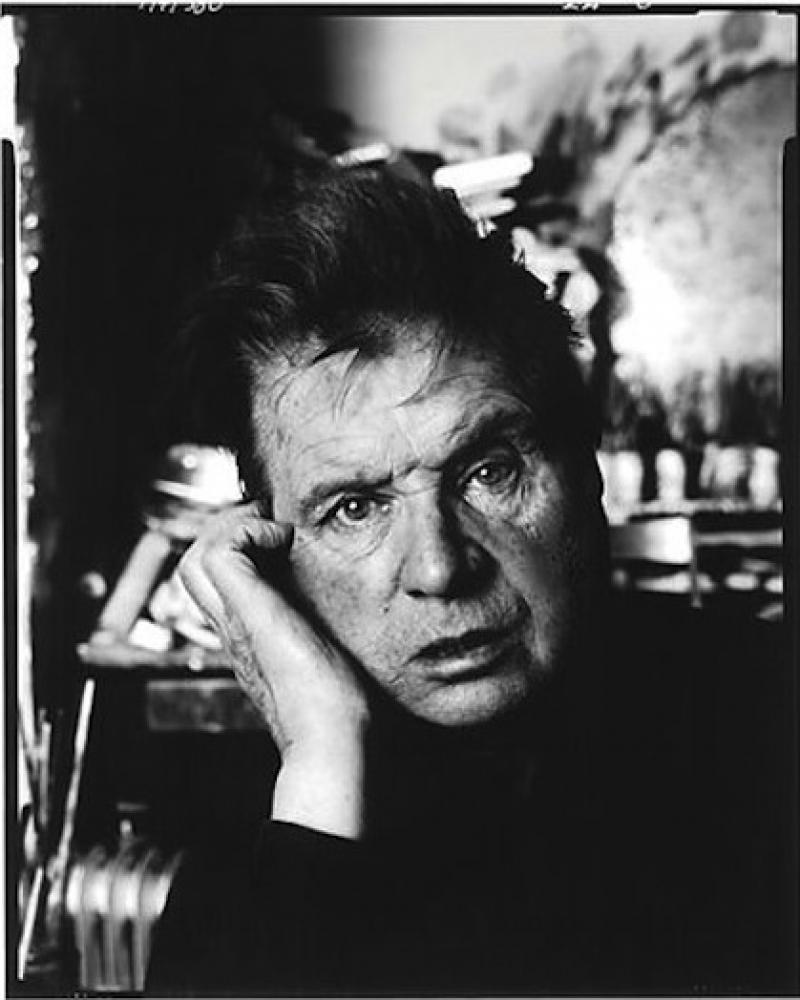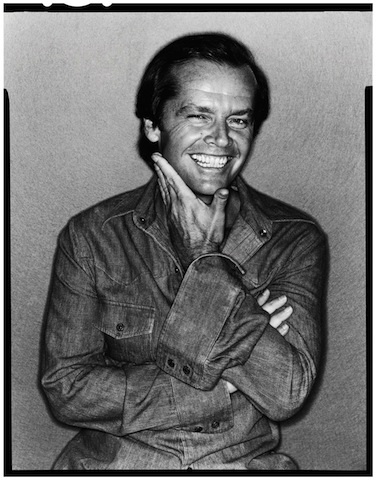Bailey's Stardust, National Portrait Gallery | reviews, news & interviews
Bailey's Stardust, National Portrait Gallery
Bailey's Stardust, National Portrait Gallery
Vital and alive, and only rarely mawkish: David Bailey's portraits of the famous and not-so-famous

Several hundred photographs, of varying scales and most of them newly printed gelatin silver prints in superb tones of greys blacks and whites, take us into a world that has been subliminally familiar to us for nearly 50 years.
Stardust is the title given to this self-selected retrospective, three years in the making, the photographer his own curator, and the word neatly encapsulates the fascinating conundrum of photography itself. As Bailey himself puts it, “it’s not the camera that takes the picture, it’s the person” and these photographs are as much about Bailey as his subject - his terrific insouciance, his seemingly natural, unforced, spontaneous eye, his alert rapidity when working. His is the stardust, for he makes his subjects – from the tribesmen of Nagaland, aborigines, and the ornamented peoples of Papua New Guinea, the models for Vogue, the politicians, entertainers, writers and artists – stars. Some can even appear strikingly unfamiliar: the boyish Damon Albarn is anguished. The spectrum from Mick Jagger’s masculinity to his androgyny and even prettiness, framed by a fur hood, is strikingly portrayed.
 The hypnotically demanding rightness of his pictures is as verbally inexplicable as the charisma and physical presences of Jack Nicholson (pictured right), or Kate Moss, neither conventionally good-looking, and he is as adept at conveying the gentle dignity and profound resilience of Nelson Mandela as he is the irritating bravura of East End hardmen. We see scores of the most memorable and most photographed (and the two are linked, although the ubiquitous nature of photography and consequent inescapable memorability, are not totally responsible for each other) through Bailey’s candid and determinedly unsparing, although surprisingly affectionate, eye.
The hypnotically demanding rightness of his pictures is as verbally inexplicable as the charisma and physical presences of Jack Nicholson (pictured right), or Kate Moss, neither conventionally good-looking, and he is as adept at conveying the gentle dignity and profound resilience of Nelson Mandela as he is the irritating bravura of East End hardmen. We see scores of the most memorable and most photographed (and the two are linked, although the ubiquitous nature of photography and consequent inescapable memorability, are not totally responsible for each other) through Bailey’s candid and determinedly unsparing, although surprisingly affectionate, eye.
There are scores of beautiful women – several of whom he had extended liaisons with, and indeed married – Jean Shrimpton, Catherine Deneuve, Marie Helvin, and his current wife of over 30 years, another model, Catherine. Bailey himself declares that he was never really interested in fashion. He did fashion, he says, irresistibly, because he liked what was in the frocks.
And in turn his sitters liked sitting. Or standing, jumping, and lying down. He climbed (in)famously in bed with Warhol (Warhol’s condition for co-operation), and we see the very young Marianne Faithfull lying wistfully supine in an urban field, a lamppost in the background emphasising the diagonals of her resting torso. Angelica Houston, whose face should not have worked according to Bailey, but who nonetheless granted her great beauty, said working with Bailey was an adventure. He was teasing, flirtatious and witty.
Not for Bailey the snapshot, the decisive moment. Everything is deliberate. The simplicity of the studio without props – just a plain white background, is peculiarly reminiscent of Irving Penn’s travelling studio of white sheets. It ensures the focus is intensely on the subject. But on Bailey’s travels, the environment is part of the ensemble, the poverty-stricken yet amazingly elaborate interiors of the natives of Nagaland as important as the dusty vast landscapes of Australia in which he photographed aboriginals, whose initial suspicion and indeed dislike of any camera was allayed by the photographer.
 Bailey is, like Hockney, addicted to experiment. (Pictured left: Self-Portrait, 1957.) He started with the Box Brownie, the family camera, then graduated to 35mm, to Polaroid, to digital in all its manifestations, and to the current phone camera. One fascinating section is his use of the film camera, the 11 X 14, about, as he says, £200 per click, with the developed image actually smaller than the negative. Here the subjects are against black; a very anguished skull-like Joseph Beuys, Mick Jagger scowling. A whole room is devoted to the Stones.
Bailey is, like Hockney, addicted to experiment. (Pictured left: Self-Portrait, 1957.) He started with the Box Brownie, the family camera, then graduated to 35mm, to Polaroid, to digital in all its manifestations, and to the current phone camera. One fascinating section is his use of the film camera, the 11 X 14, about, as he says, £200 per click, with the developed image actually smaller than the negative. Here the subjects are against black; a very anguished skull-like Joseph Beuys, Mick Jagger scowling. A whole room is devoted to the Stones.
His unassuming and attractive confidence also leads to a fine sequence of fellow photographers, from Cartier-Bresson, whom Bailey regards as a surrealist, to Bruce Weber, a rare outdoor shot of the photographer and his dogs. Francis Bacon (main picture) was almost an obsessive subject (a painter absorbed by what a photographic vision could mean).
There is a very rare descent into a kind of sentimentality, even mawkishness, in a wall of imagery devoted over decades to his fourth wife Catherine, each photograph unlabelled, with several of one of their babies being born; and a wall of still lifes in colour with skulls, an unnecessary meditation on mortality, for photography usually does not function well as a vehicle for the posed vanitas. Neither worship nor intimations of mortality work well for Bailey. Life, from its inescapable banality to its irrepressible vitality, is his metier.
There are four vitrines of books and ephemera which amplify a career based on an astonishingly high level of visual scrutiny, a striking imagination which, using minimal external props, manages to hone in with a laser-like intensity on something essential that portrays a believable persona for each subject – whether already a colossus, an emerging star, or an “ordinary” person. The visitor somehow feels on surprisingly intimate terms with these people whom we will never know, and that somehow Bailey makes us feel we do.
Explore topics
Share this article
The future of Arts Journalism
You can stop theartsdesk.com closing!
We urgently need financing to survive. Our fundraising drive has thus far raised £49,000 but we need to reach £100,000 or we will be forced to close. Please contribute here: https://gofund.me/c3f6033d
And if you can forward this information to anyone who might assist, we’d be grateful.

Subscribe to theartsdesk.com
Thank you for continuing to read our work on theartsdesk.com. For unlimited access to every article in its entirety, including our archive of more than 15,000 pieces, we're asking for £5 per month or £40 per year. We feel it's a very good deal, and hope you do too.
To take a subscription now simply click here.
And if you're looking for that extra gift for a friend or family member, why not treat them to a theartsdesk.com gift subscription?
more Visual arts
 'We are bowled over!' Thank you for your messages of love and support
Much-appreciated words of commendation from readers and the cultural community
'We are bowled over!' Thank you for your messages of love and support
Much-appreciated words of commendation from readers and the cultural community
 Photo Oxford 2025 review - photography all over the town
At last, a UK festival that takes photography seriously
Photo Oxford 2025 review - photography all over the town
At last, a UK festival that takes photography seriously
![SEX MONEY RACE RELIGION [2016] by Gilbert and George. Installation shot of Gilbert & George 21ST CENTURY PICTURES Hayward Gallery](https://theartsdesk.com/sites/default/files/styles/thumbnail/public/mastimages/Gilbert%20%26%20George_%2021ST%20CENTURY%20PICTURES.%20SEX%20MONEY%20RACE%20RELIGION%20%5B2016%5D.%20Photo_%20Mark%20Blower.%20Courtesy%20of%20the%20Gilbert%20%26%20George%20and%20the%20Hayward%20Gallery._0.jpg?itok=7tVsLyR-) Gilbert & George, 21st Century Pictures, Hayward Gallery review - brash, bright and not so beautiful
The couple's coloured photomontages shout louder than ever, causing sensory overload
Gilbert & George, 21st Century Pictures, Hayward Gallery review - brash, bright and not so beautiful
The couple's coloured photomontages shout louder than ever, causing sensory overload
 Lee Miller, Tate Britain review - an extraordinary career that remains an enigma
Fashion photographer, artist or war reporter; will the real Lee Miller please step forward?
Lee Miller, Tate Britain review - an extraordinary career that remains an enigma
Fashion photographer, artist or war reporter; will the real Lee Miller please step forward?
 Kerry James Marshall: The Histories, Royal Academy review - a triumphant celebration of blackness
Room after room of glorious paintings
Kerry James Marshall: The Histories, Royal Academy review - a triumphant celebration of blackness
Room after room of glorious paintings
 Folkestone Triennial 2025 - landscape, seascape, art lovers' escape
Locally rooted festival brings home many but not all global concerns
Folkestone Triennial 2025 - landscape, seascape, art lovers' escape
Locally rooted festival brings home many but not all global concerns
 Sir Brian Clarke (1953-2025) - a personal tribute
Remembering an artist with a gift for the transcendent
Sir Brian Clarke (1953-2025) - a personal tribute
Remembering an artist with a gift for the transcendent
 Emily Kam Kngwarray, Tate Modern review - glimpses of another world
Pictures that are an affirmation of belonging
Emily Kam Kngwarray, Tate Modern review - glimpses of another world
Pictures that are an affirmation of belonging
 Kiefer / Van Gogh, Royal Academy review - a pairing of opposites
Small scale intensity meets large scale melodrama
Kiefer / Van Gogh, Royal Academy review - a pairing of opposites
Small scale intensity meets large scale melodrama
 Jenny Saville: The Anatomy of Painting, National Portrait Gallery review - a protégé losing her way
A brilliant painter in search of a worthwhile subject
Jenny Saville: The Anatomy of Painting, National Portrait Gallery review - a protégé losing her way
A brilliant painter in search of a worthwhile subject
 Abstract Erotic, Courtauld Gallery review - sculpture that is sensuous, funny and subversive
Testing the boundaries of good taste, and winning
Abstract Erotic, Courtauld Gallery review - sculpture that is sensuous, funny and subversive
Testing the boundaries of good taste, and winning
 Edward Burra, Tate Britain review - watercolour made mainstream
Social satire with a nasty bite
Edward Burra, Tate Britain review - watercolour made mainstream
Social satire with a nasty bite

Add comment